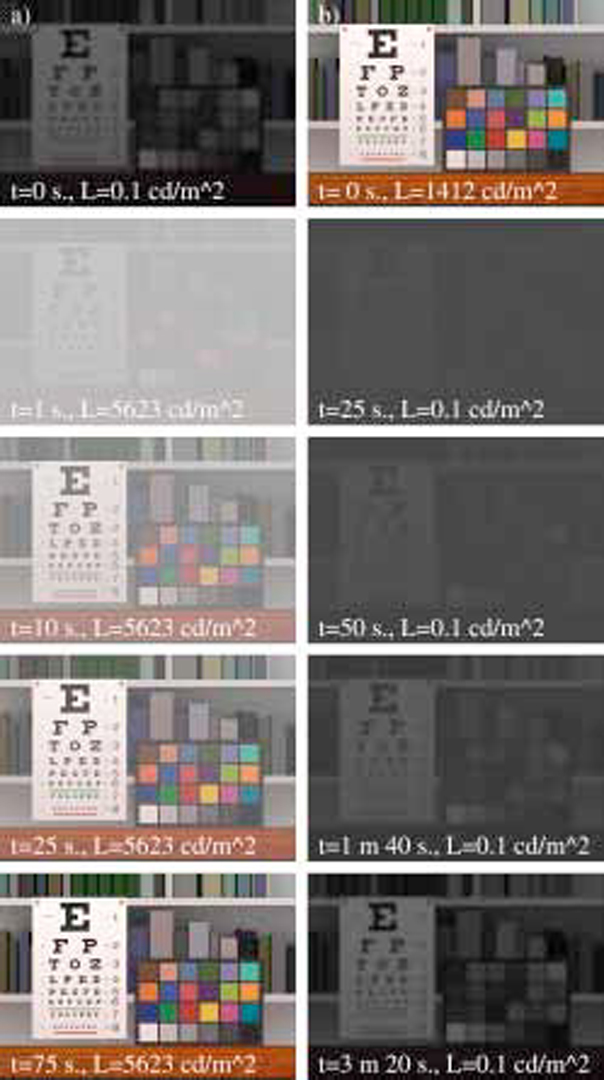“A model of visual adaptation for realistic image synthesis” by Ferwerda, Pattanaik, Shirley and Greenberg
Conference:
Type(s):
Title:
- A model of visual adaptation for realistic image synthesis
Presenter(s)/Author(s):
Abstract:
In this paper we develop a computational model of visual adaptation for realistic image synthesis based on psychophysical experiments. The model captures the changes in threshold visibility, color appearance, visual acuity, and sensitivity over time that are caused by the visual system’s adaptation mechanisms. We use the model to display the results of global illumination simulations illuminated at intensities ranging from daylight down to starlight. The resulting images better capture the visual characteristics of scenes viewed over a wide range of illumination levels. Because the model is based on psychophysical data it can be used to predict the visibility and appearance of scene features. This allows the model to be used as the basis of perceptually-based error metrics for limiting the precision of global illumination computations.
References:
- Adelson E.H. (1982). Saturation and adaptation in the rod system. Vision Research, 22, 1299-1312.
- Aguilar, M. ~z Stiles, W.S. (1954). Saturation of the rod mechanism of the retina at high levels of stimulation. Optica Acta, I, 59-65.
- Baker, H.D. (1949). The course of foveal adaptation measured by the threshold intensity increment. Journal of the Optical Society of America, 39, 172-179.
- CIE (1981). An analytic model for describing the influence of lighting parameters upon visual performance, vol. I. Technical foundations. CIE 19/2.1, Technical committee 3.1.
- Crawford, B.H. (1947). Visual adaptation in relation to brief conditioning stimuli. Proceedings of the Royal Society of London, Series B, 128, 283-302.
- Granit R., Munsterhjelm, A., and Zewi, M. (1939). The relation between concentration of visual purple and retinal sensitivity to light during dark adaptation. Journal of Physiology, 96, 31-44.
- Hecht, S. (1934). Vision II: the nature of the photoreceptor process. In C. Murchison (Ed.), A handbook of general experimental psychology. Worchester, Massachusetts: Clark University Press.
- Hood, D.C. & Finkelstein M.A. (1986). Visual sensitivity. In K.Boff, L. Kaufman, ~z J. Thomas (Eds.), Handbook of Perception and Human Performance (Volume I). 5-I-5-66.
- IES (1993). Lighting handbook:reference and application volume, (8th edition). Mark S. Rea (Ed.). New York: Illuminating Engineering Society of North America.
- Meyer, G.W. (1986) Color calculation for and perceptual assessment of computer graphic images. Ph.D. thesis, Cornell University.
- Mueller, C.G. (1951). Frequency of seeing functions for intensity discrimination at various levels of adapting intensity. Journal of General Physiology, 34, 463-474.
- Minnaert, M. (1954) The nature of light and color in the open air. New York: Dover.
- Pugh, E.N. (1988). Vision: physics and retinal physiology, In R.C. Atkinson (Ed.), Steven’s handbook of experimental psychology, (2nd edition). New York: Wiley.
- Riggs, L.A. (1971) Vision. In J.W. Kling & L.A. Riggs (Eds.), Woodworth and Schlosberg’s Experimental Psychology , (3rd edition). New York: Holt, Rinehart, and Winston.
- Shaler, S. (1937) The relation between visual acuity and illumination. Journal of General Physiology, 21, 165-188.
- Spencer, G., Shirley P., Zimmerman, K. ~z Greenberg, D. (1995). Physically-based glare effects for computer generated images, Proceedings ACM SIGGRAPH ’95, 325-334.
- Spillman, L., ~z Werner, J.S. (Eds.) (1990). Visual perception: the neurophysiological foundations. SanDiego: Academic Press.
- Stevens, S.S., ~z Stevens, J.C. (1960). Brightness function: parametric effects of adaptation and contrast, Journal of the Optical Society of America , 53, 1139.
- Tumblin, J., and Rushmeier, H. (1993). Tone Reproduction for Realistic Images, IEEE Computer Graphics and Applications, 13(6), 42-48.
- Ward, G. (1994). A contrast-based scalefactor for luminance display. In P.S. Heckbert (Ed.), Graphics Gems IV, Boston: Academic Press Professional.
- Wyszecki G. ~z Stiles W.S. (1982). Color science: concepts and methods, quantitative data and formulae (2nd edition). New York: Wiley.





